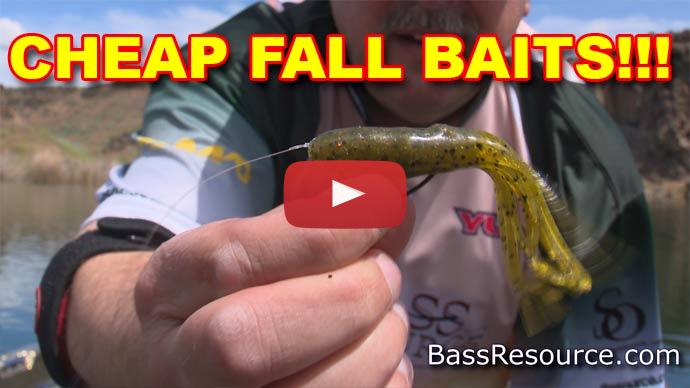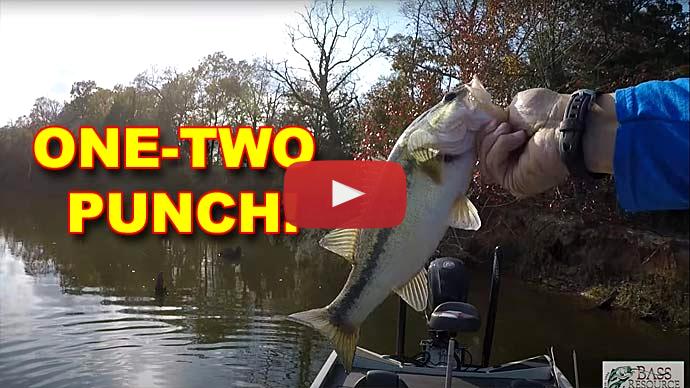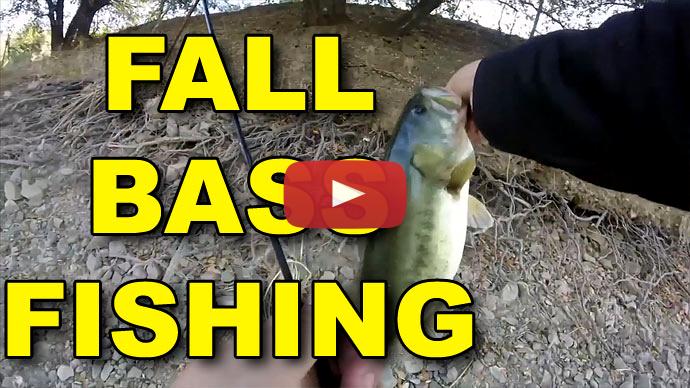This video is about the best lures to use for fall fishing starting with topwaters. Topwater can be dynamite this time of year. Topwaters are good during the summer and in the spring, but I'm telling you what, in the fall, that's my favorite time to throw topwaters because a lot of times, the bass are busting shad and other bait fish right up on the surface, and that's when a topwater shines. One of the ones that I like to throw the most are the Zara Spook types, the walking the dog type baits, the Zara Puppies are really good, so are the Sammy's. Those are excellent type baits to throw. One thing to keep in mind is during the fall, the bait fish tend to be a little bit smaller so you might want to use a little bit smaller versions of those baits. Just make sure you can throw them really far. So this might not be the time to use baitcasting gear, you might want to use spinning because a lot of times when busting activity happens, it's usually out of casting range. You got to get up close enough to reach them, and what you want to do is cast past that activity and bring it into it. And typically, with spinning gear, you can make longer casts and lighter lines and bring it back quickly, fast-moving. Not your typical sachet move, but move it quickly, like this, very quick. You're just constantly reeling, constantly popping your rod. Just bringing it back so your bait does this. And a lot of times that elicits a bite.
Next bait to use are crankbaits. Now this time of year, they're gonna be up really shallow. So you don't need super deep diving crankbaits. But you do need a variety of crankbaits to cover the shallow depths, starting with a lipless type crankbait, like a Wameku shad, like a 60, that's a quarter ounce. That's the one that works really well for me. It's a smaller bait fish profile, like I just mentioned. You can fish it one to five feet deep. The cool thing about it is that it sinks so you can get it down to like rocks if you're fishing, say, riprap. You want to ricochet off of the rocks, sort of bounce off the rocks. That type of thing works really well for that. If you get an area where there's a lot of woody cover and you're afraid of getting hung up, then move over to a square bill crankbait. Again, you're staying shallow, but square bill works really well for those type of things so the hooks don't get embedded in the wood. It also goes through sparse weeds and spray and isolated weed cover, which again, can be really good for the fall.
If you want to get a little bit deeper, then going for like a SPRO RkCrawler 50 or 55. That gets down to about 8 feet deep or so. Those are the ones that can...again, it's a smaller profile baitfish profile that can really attract a lot of bites this time of year. That's what the bass are keying on, and so that smaller profile crankbait works dynamite this time of year. Also a Little John with that tight wiggle. Get like a Little John 60. It goes down about 12 feet deep. Again, that tight wiggle you get with that bill, you can bounce it off things and get it down a little bit deeper, maybe along weed lines. I like fishing weed lines in natural lakes because in a natural lake, you get this abundance of vegetation because the water levels aren't fluctuating so much. So you have a lot more vegetation. Those outside weed lines with like a Little John, those bass will sit right inside the weed lines and dart out and smash those baits. So those are the crankbaits that you want to have for the fall.
The next lures you want to throw during the fall are jerk baits. Again, you're getting a bit of a theme here. This is bait fish imitating type bait, and it imitates an injured or dying bait fish which is easy money for bass. So you want from shallow to deeper diving, suspending model jerk baits, like you want to go with the McStick 110 for real shallow water. You can fish these fast or slow because they do suspend, so just depending on the activity level of the fish. That's gonna be real shallow. The McRip 85. That one will go down to about 8 feet or so, maybe 10. That gets a little bit deeper and it just hovers in a nose-down position. So again, you can you can fish it fast or slow. Here's a video. It's showing the inventor of this jerk bait, Mike McClelland. He really knows jerk baits. He's built a career around them. Here he is fishing it in early fall, and you can see the cadence that he's using. That's a good starting point when the water is warmer, the air temperatures are warmer. As the water cools down, you'll want to extend those pauses and maybe not jerk as much. And just kind of calm down a little bit on your retrieve. But again, the bass are going to tell you so be ready to adapt.
Mike: A lot of times when I'm throwing a 110 and I'm wanting to suspend that bait, I literally have to make myself just sit there and count, 1001, 1002, 1003, 1004 in my head, and it makes me slow down. And I think that's probably the most effective thing that I've ever learned about really making myself slow down. Again, slow gear ratio reel is really, really important. Five to one gear ratio. Eight to 12 pound Sunline FC crank. Wind that bait down when you first throw it in, stop it, twitch it a couple times. Count to 8 or 10, let it set, take up the slack, give it a good long pull. Stop it again. Then I usually follow that up with a couple twitches. Just kind of a pull, twitch, twitch cadence that I like the best for fishing that McStick 110 suspended in cold water.
Glenn: And then finally, to get a little bit down deeper is a McStick 110 plus one. That will get you down a little bit deeper, more about the 12 foot range And just get that bait down there and just let it stick, just let it hover. This is great when the water is a little bit cooler, and they're hanging out by those ledges or those points by creek channels, or maybe along deeper docks and deeper weed lines. Just use that McStick 110 plus one to kind of get it down in there and just sit. And it's just like candy man. You're just holding this right in front of the fish. It's like a snack. They may not want it right away, but if you just wave it in front of their face, eventually they're gonna hit it. And that's what this bait does.
Now those are hard jerk baits. Now you want to get soft jerk baits also. Soft jerk baits like the Zoom Fluke are a standard in virtually every bass angler's arsenal. Especially during the fall. You can rig them weightless and get them near the surface and imitate a fleeing bait fish. This is great when the bass are just chasing bait fish on the surface you see them popping out. That's when you throw this weightless fluke and just pop it back real quick. And it looks just like that and it usually gets clocked. But if the activity isn't as active, then you can put it on a weighted hook and get it down a little bit deeper. White pearl is really the only color that you need. I mean, there's a lot of colors it comes in, basically every color of the rainbow. But I found that white pearl works best for me. And again, in the fall, smaller bait fish size tends to work better. So maybe downsizing from that standard five-inch fluke to a three-inch.
The next bait you got to have handy is a spinnerbait. I mean spinnerbaits work year-round and that's one of my favorite baits to throw throughout the entire year. But in the fall, they can be especially productive because if you use double willow leaf blades, that gives that bait fish profile look and that flash, just with a white skirt or maybe a white chartreuse skirt is all you need. Again, I wanted to come back real fast. That's the keys is triggering that strike, is fast movement. So instead of the standard 3/8-ounce bait that most people throw, size up to a half ounce and bring it back so fast that it's near the surface it just bulges the water. You don't want it to break the surface, but get it to bulge right underneath. So a half ounce with double willow leaf, silver blades are perfect. If the bass are coming up and following it but not committing, change the colors of the blades to gold and you're good to go. Typically that'll elicit a bite, just a change in the blades. But also, I sometimes will switch to a Colorado blade. Now because Colorado blade's a double Colorado blade, they have more resistance in the water than the willow leaf, that will make that bait tend to fall over, lay over. So I'll move up to a 3/4-ounce spinner bait. Same colors, same colored blades, but now a double Colorado and that puts out a bigger profile, has a little more vibration and sometimes that's all it takes to trigger a bite. So the key thing here is to play around with the sizes and the colors of the base as far as the blades, kind of types as well, and the speed, and you're gonna get bass to bite them, I guarantee. The spinnerbaits are a blast in the fall.
And then the last baits that you want to use is the drop shot or drop shot rig. I shouldn't even call it a bait. It's actually a rig, but the baits that you put on it are going to be bait fish imitating style plastics, right? I like to throw a little hand pour three-inch bait fish imitating style baits. You can throw small three inch flukes on it, tubes. The pin stick works really well. I like that. You know anything that gives off kind of the small bait fish profile. Those are great to throw, the drop shot, when the action isn't fast and furious. When the bite's real slow, perhaps you've had a front come through, fall has a lot of fronts, especially as you're getting closer to wintertime, you get stronger and stronger fronts that tends to push the fish down deeper, and tends to slow the bite down. That's when a drop shot shines. But still stick to those bait fish imitating type of baits and you'll do really well. Again, white works well, any pearl, anything that looks like a shad, green pumpkin works every time. And so you don't have to go too crazy with all the colors. Just make sure that you're doing the best to match the forage colors, the forage in your body of water. So those are the top baits to use in the fall. If you got those ready to go, you're gonna catch a lot of fish.



